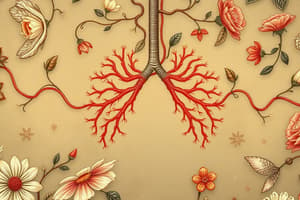Podcast
Questions and Answers
What is the primary outcome of glycolysis?
What is the primary outcome of glycolysis?
- Formation of acetyl CoA
- Generation of NADH from NAD+
- Production of 6 molecules of carbon dioxide
- Net gain of 2 ATP molecules (correct)
Where does the link reaction occur within the cell?
Where does the link reaction occur within the cell?
- Nucleus
- Mitochondrial matrix (correct)
- Cell membrane
- Cytoplasm
Which of the following is produced during the Krebs cycle?
Which of the following is produced during the Krebs cycle?
- 4 molecules of carbon dioxide
- 2 molecules of pyruvate
- 1 molecule of FADH2 (correct)
- 2 ATP molecules
What is the main role of NADH in aerobic respiration?
What is the main role of NADH in aerobic respiration?
How many carbon atoms are released as carbon dioxide during the link reaction per glucose molecule?
How many carbon atoms are released as carbon dioxide during the link reaction per glucose molecule?
Which statement about oxidative phosphorylation is correct?
Which statement about oxidative phosphorylation is correct?
What is formed when acetyl CoA enters the Krebs cycle?
What is formed when acetyl CoA enters the Krebs cycle?
What is the initial energy investment required for glycolysis?
What is the initial energy investment required for glycolysis?
What is the net ATP gain from glycolysis?
What is the net ATP gain from glycolysis?
What is produced during the link reaction?
What is produced during the link reaction?
How many times does the Krebs cycle turn for each glucose molecule?
How many times does the Krebs cycle turn for each glucose molecule?
Which molecule combines with acetyl CoA to initiate the Krebs cycle?
Which molecule combines with acetyl CoA to initiate the Krebs cycle?
In which part of the cell does glycolysis occur?
In which part of the cell does glycolysis occur?
Flashcards
What is aerobic respiration?
What is aerobic respiration?
The process of converting glucose into ATP in the presence of oxygen, yielding significantly more ATP than anaerobic respiration. It proceeds in four main stages: glycolysis, the link reaction, the Krebs cycle, and oxidative phosphorylation.
What is glycolysis?
What is glycolysis?
The initial stage of both aerobic and anaerobic respiration, occurring in the cytoplasm. It involves the breakdown of glucose into two pyruvate molecules, generating a net gain of 2 ATP and carrying high-energy electrons via NADH.
What is the link reaction?
What is the link reaction?
The transition between glycolysis and the Krebs cycle, occurring in the mitochondrial matrix. It involves decarboxylation of pyruvate, forming acetyl CoA, and reducing NAD+ to NADH.
What is the Krebs cycle?
What is the Krebs cycle?
Signup and view all the flashcards
What is oxidative phosphorylation?
What is oxidative phosphorylation?
Signup and view all the flashcards
What is glucose?
What is glucose?
Signup and view all the flashcards
What is pyruvate?
What is pyruvate?
Signup and view all the flashcards
What is acetyl CoA?
What is acetyl CoA?
Signup and view all the flashcards
Study Notes
Aerobic Respiration Overview
- Aerobic respiration converts glucose into ATP (adenosine triphosphate) using oxygen.
- It's highly efficient, producing significantly more ATP than anaerobic respiration.
- The process has four main stages: glycolysis, link reaction, Krebs cycle, and oxidative phosphorylation.
Glycolysis
- Glycolysis is the first stage of both aerobic and anaerobic respiration.
- It occurs in the cytoplasm.
- Glucose (a 6-carbon molecule) is broken down into two pyruvate molecules (3-carbon each).
- It requires an initial investment of 2 ATP but generates 4 ATP, resulting in a net gain of 2 ATP.
- NAD+ is reduced to NADH, carrying high-energy electrons.
- Two water molecules are produced during this process.
- Two ATP and two NADH are generated per glucose molecule.
Link Reaction
- The link reaction happens in the mitochondrial matrix.
- Pyruvate from glycolysis enters the matrix.
- Pyruvate is decarboxylated (loses a carbon atom as CO2).
- The remaining two-carbon molecule combines with coenzyme A to form acetyl CoA.
- NAD+ is reduced to NADH during this conversion.
- This links glycolysis to the Krebs cycle.
- One NADH is produced per pyruvate molecule.
- One CO2 molecule is released per pyruvate.
Krebs Cycle
- The Krebs cycle (also called the citric acid cycle) takes place in the mitochondrial matrix.
- Acetyl CoA enters the cycle.
- Acetyl CoA combines with oxaloacetate to form citrate.
- A series of redox reactions releases carbon dioxide.
- NAD+ is reduced to NADH, and FAD is reduced to FADH2, both carrying high-energy electrons.
- Oxaloacetate is regenerated, enabling the cycle to continue.
- ATP is directly produced.
- One complete turn of the cycle yields 1 ATP, 3 NADH molecules, and 1 FADH2.
- Two CO2 molecules are released as waste products.
Oxidative Phosphorylation
- Oxidative phosphorylation happens in the inner mitochondrial membrane.
- Electrons from NADH and FADH2 move along an electron transport chain.
- Energy from electron transfer pumps protons (H+) across the inner membrane.
- This creates a proton gradient.
- Protons flow back across the membrane through ATP synthase.
- ATP synthesis occurs using energy from proton flow, this produces ATP from ADP and inorganic phosphate (Pi).
- Oxygen is the final electron acceptor, combining with protons to form water.
Studying That Suits You
Use AI to generate personalized quizzes and flashcards to suit your learning preferences.





